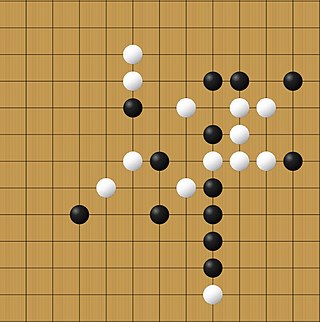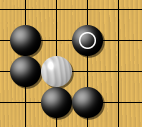
Sternhalma, commonly known as Chinese checkers or Chinese chequers, is a strategy board game of German origin that can be played by two, three, four, or six people, playing individually or with partners. The game is a modern and simplified variation of the game Halma. "Complexity: requires no counting or spelling; even young children can play."

Pente is an abstract strategy board game for two or more players, created in 1977 by Gary Gabrel. A member of the m,n,k game family, Pente stands out for its custodial capture mechanic, which allows players to "sandwich" pairs of stones and capture them by flanking them on either side. This changes the overall tactical assessments players face when compared to pure placement m,n,k games such as Gomoku.

The game of go has simple rules that can be learned very quickly but, as with chess and similar board games, complex strategies may be employed by experienced players.

Go is an abstract strategy board game for two players in which the aim is to surround more territory than the opponent. The game was invented in China more than 2,500 years ago and is believed to be the oldest board game continuously played to the present day. A 2016 survey by the International Go Federation's 75 member nations found that there are over 46 million people worldwide who know how to play Go and over 20 million current players, the majority of whom live in East Asia.

The rules of Go have seen some variation over time and from place to place. This article discusses those sets of rules broadly similar to the ones currently in use in East Asia. Even among these, there is a degree of variation.

Within most systems and at most levels in the game of Go, a handicap is given to offset the strength difference between players of different ranks.

Go proverbs are traditional proverbs relating to the game of Go, generally used to help one find good moves in various situations during a game. They are generalisations and thus a particular proverb will have specific situations where it is not applicable. Knowing when a proverb is inapplicable is part of the process of getting stronger as a Go player. Indeed, several proverbs contradict each other—however they agree in as much as they are advising the player to pay attention to the stated situation.

Computer Go is the field of artificial intelligence (AI) dedicated to creating a computer program that plays the traditional board game Go. The field is sharply divided into two eras. Before 2015, the programs of the era were weak. The best efforts of the 1980s and 1990s produced only AIs that could be defeated by beginners, and AIs of the early 2000s were intermediate level at best. Professionals could defeat these programs even given handicaps of 10+ stones in favor of the AI. Many of the algorithms such as alpha-beta minimax that performed well as AIs for checkers and chess fell apart on Go's 19x19 board, as there were too many branching possibilities to consider. Creation of a human professional quality program with the techniques and hardware of the time was out of reach. Some AI researchers speculated that the problem was unsolvable without creation of human-like AI.

Life and death (死活) is a fundamental concept in the game of Go, where the status of a distinct group of stones is determined as either being "alive", where they may remain on the board indefinitely, or "dead", where the group will be lost as "captured". The basic idea can be summarized by:

In go and shōgi, a jōseki or jouseki is the studied sequences of moves for which the result is considered balanced for both black and white sides.

Professional Go handicaps were a system developed in Japan, in the Edo period, for handicapping professional players of the game of Go against each other. With the abolition of the Oteai system, which from the 1920s had used some handicap games to determine the Go ranking of professional players, this system has become obsolete. It is now completely superseded by the use of komidashi. Knowledge of it is required to understand the conditions of play in historical Go matches, particularly the jubango that died out around 1960.
Akaboshi Intetsu was a Japanese professional 7 dan Go player.

There are many variations of the simple rules of Go. Some are ancient digressions, while other are modern deviations. They are often side events at tournaments, for example, the U.S. Go Congress holds a "Crazy Go" event every year.
A kofight is a tactical and strategic phase that can arise in the game of go.

The blood-vomiting game is a famous game of Go of the Edo period of Japan, played on June 27, 1835, between Hon'inbō Jōwa (white) and Akaboshi Intetsu (black). It is noted for the premature death of the go prodigy Akaboshi Intetsu who coughed up blood after the game and died a few months later. Selected moves of the game are shown in diagrams.

In the game of Go, shape describes the positional qualities of a group of stones. Descriptions of shapes in go revolve around how well a group creates or removes life and territory. Good shape can refer to the efficient use of stones in outlining territory, the strength of a group in a prospective fight, or making eye shapes so that a group may live. Bad shapes are inefficient in outlining territory and are heavy. Heavy groups cannot easily make eye shapes and are therefore good targets for attack. Understanding and recognizing the difference between good shape and bad is an essential step in becoming a stronger player.

An Internet Go server is a server that allows players of the game of Go to play against opponents online. The two fundamental types of Go server are real-time servers and turn-based servers.
Darkforest is a computer go program developed by Meta Platforms, based on deep learning techniques using a convolutional neural network. Its updated version Darkfores2 combines the techniques of its predecessor with Monte Carlo tree search. The MCTS effectively takes tree search methods commonly seen in computer chess programs and randomizes them. With the update, the system is known as Darkfmcts3.




